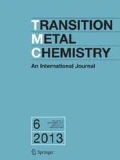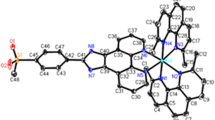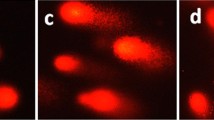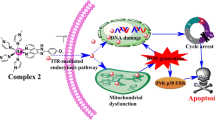Abstract
A phenanthrene derivative with a pendant methanol amidogen TFCPIP and its two ruthenium(II) complexes [Ru(phen)2(TFCPIP)](ClO4)2 (1) and [Ru(dmp)2(TFCPIP)](ClO4)2 (2) (phen = 1,10-phenanthroline, dmp = 2,9-dimethyl-1,10-phenanthroline, TFCPIP = 2-(2,3,5,6-tetrafluoro-4-aminoethanolphenyl)[4,5-f]-imidazo[1,10]phenanthroline) were synthesized, and the anticancer properties of the two complexes were examined. Both the complexes displayed certain anticancer activities against the selected SGC-7901, BEL-7402, HeLa, A549, MG-63, HepG2, PC-12 and SiHa cancer cells, with the highest cytotoxic activities against SGC-7901. The cell biology experiments for exploring toxicity mechanism with fluorescence imaging technique and flow cytometry demonstrated that the complexes can trigger apoptosis of SGC-7901 cells with an increase in ROS level, a decrease in mitochondrial membrane potential, and effectively inhibit cell invasion and cell growth at G2/M phase, implicating that the complexes induce cellular apoptosis through a ROS-mediated mitochondrial dysfunction pathway.












Similar content being viewed by others
References
Jacques F, Isabelle S, Rajesh D, Sultan E, Colin M, Marise R, Donald MP, David F, Freddie B (2015) Int J Cancer 136:E359–E386
Umar N, Ndumiso M, Mahmoud ES (2017) Drug Des Dev Ther 11:599–616
Sarkar A (2018) Pharm Pat Anal 7:33–46
Lazarević T, Rilak A, Bugarčić ŽD (2017) Eur J Med Chem 142:8–31
Shahana D, Ganna VK (2016) Cancer Chemother Pharmacol 6:1103–1124
Franz H, Johannes K, Gilles G (2017) Acc Chem Res 50:2727–2736
Bergamo A, Sava G (2007) Dalton Trans 13:1267–1272
Anna N, Gilles G (2017) Chem Soc Rev 46:7317–7337
Fergus EP, Sandra AB, Salvador B, Williams DC, John MK, Thorfinnur G (2017) Chem Soc Rev 46:7706–7756
Kalaivani P, Prabhakaran R, Poornima P, Huang R, Hornebecq V, Dallemer F, Padma VV, Natarajan K (2013) RSC Adv 3:20363–20378
Devi CS, Nagababu P, Natarajan S, Deepika N, Reddy PV, Veerababu N, Singh SS, Satyanarayana S (2014) Eur J Med Chem 72:160–169
Zhu JW, Liu SH, Zhang GQ, Xu HH, Wang YX, Wu Y, Liu YM, Wang Y, Liang JB, Guo QF (2016) J Membr Biol 4:483–492
Bing T, Dan W, Shang-Hai L, Hui-Hui Y, Cheng Z, Xiu-Zhen W, Chuan-Chuan Z, Yun-Jun L (2017) J Inorg Biochem 173:93–104
Isabella R, Facchetti G, Lucchini G, Castiglioni E, Marchianò S, Ferri N (2017) Bioorgan Med Chem 25:1907–1913
Liang ZH, Liu HY, Jiang GB, Wen JY, Liu YJ, Xiao XY (2016) Chin J Chem 34:997–1005
Ravi KV, Kamakshi D, Praveen KY, Vinoda RM, Rajender RM, Nagamani C, Ravi C, Suman ST, Ch. Mohan R, Satyanarayana S (2018) New J Chem 42:846–859
Nowak-Sliwinska P, Clavel CM, Pǎunescu E, Winkel MT, Griffioen AW, Dyson PJ (2015) Mol Pharm 12:3089–3096
Sullivan BP, Salmon DJ, Meyer TJ (1978) Inorg Chem 17:3334–3341
Collin JP, Sauvage JP (1986) Inorg Chem 25:135–141
Mosmann T (1983) J Immunol Methods 65:55–63
Lo KK, Lee TK, Lau JS, Poon WL, Cheng SH (2008) Inorg Chem 47:200–208
Zhang XX, Fu ZY, Zhang ZY, Miao C, Xu PF, Wang T, Yang LY, Cheng SP (2012) Environ Sci Technol 46:11319–11326
Smith PK, Krohn RI, Hermanson GT, Mallia AK, Gartner FH, Provenzano MD, Fujimoto EK, Goeke NM, Olson BJ, Klenk DC (1985) Anal Biochem 150:76–85
Zhang C, Lai SH, Zeng CC, Tang B, Wan D, Xing DG, Liu YJ (2016) J Biol Inorg Chem 21:1047–1060
Zeng L, Chen Y, Liu J, Huang H, Guan R, Ji L, Chao H (2016) Sci Rep 6:19449
Chen TF, Wong YS (2008) Cell Mol Life Sci 65:2763–2775
Chen TF, Wong YS (2009) Int J Biochem Cell Biol 41:666–676
Martin A, Byrne A, Burke CS, Forster RJ, Keyes TE (2014) J Am Chem Soc 136:15300–15309
Luo Z, Yu L, Yang F, Zhao Z, Yu B, Lai H, Wong KH, Ngai SM, Zheng W, Chen T (2014) Metallomics 6:1480–1490
Thornberry NA, Rano TA, Peterson EP, Rasper DM, Timkey T, Garcia-Calvo M, Houtzager VM, Nordstrom PA, Roy S, Vaillancourt JP, Chapman KT, Nicholson DWA (1997) J Biol Chem 272:17907–17911
Martinou JC, Youle RJ (2011) Dev Cell 21:92–101
Shi Y (2002) Mol Cell 9(3):459–470
Thornberry NA, Lazebnik Y (1998) Science 281:1312–1316
Matthew B, Luis RM, Rebeka LDG, Enrique C, Lawrence HB (2013) BMC Cell Biol 14(32):1–9
Acknowledgements
This work was supported by the Natural Science foundation of Guangdong Province (Nos2014A030307015), Special Cultivation Funds for Guangdong College Students’ Scientific and Technological Innovation, Entrepreneurship Training Project and Shaoguan university.
Author information
Authors and Affiliations
Corresponding author
Additional information
Publisher's Note
Springer Nature remains neutral with regard to jurisdictional claims in published maps and institutional affiliations.
Rights and permissions
About this article
Cite this article
Hong, XL., Xu, J., Jiang, RH. et al. Ruthenium(II) complexes containing a pendant methanol amidogen induce apoptosis in SGC-7901 cells through a ROS-mediated mitochondrial dysfunction pathway. Transit Met Chem 45, 129–138 (2020). https://doi.org/10.1007/s11243-019-00365-9
Received:
Accepted:
Published:
Issue Date:
DOI: https://doi.org/10.1007/s11243-019-00365-9




